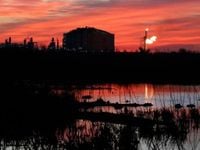In a week marked by pivotal decisions and heated debate, the future of fossil fuel infrastructure in Australia and the United States has been thrown into sharp relief. On one side of the globe, Queensland’s aging coal-fired power plants are at the center of a national conversation about energy security and climate commitments. Meanwhile, in Louisiana, a judge’s ruling has halted the construction of a major liquefied natural gas (LNG) terminal, demanding a closer look at the environmental and social costs of the Gulf Coast’s gas boom.
On October 16, 2025, Matt Kean, chair of Australia’s Climate Change Authority, voiced deep skepticism over the Queensland government’s plan to keep the Callide coal power station running for nearly two more decades. Speaking at the Investor Group on Climate Change summit, Kean didn’t mince words: "The idea that you can extend Callide – which, don’t forget, was out for the last couple of years because it didn’t work – the idea you can extend that for another 19 years is for the birds." His comments, reported by AAP, reflect growing doubts about the viability of aging coal plants, especially given Callide’s recent string of disasters, including an explosion and fire in 2021 that caused widespread blackouts.
Kean pointed out that the vast majority of Australia’s coal-fired power stations are nearing the end of their technical life. "Ninety per cent of the coal-fired power stations that have been underpinning this economy will be at an end of technical life by 2035," he said. The message was clear: the country’s energy future can’t rely on patching up old coal plants. Instead, Kean stressed the urgent need to replace them with wind, solar, and energy storage to meet national climate goals—specifically, a 62-70% reduction in emissions by 2035, as advised by the Climate Change Authority.
Yet, not everyone is ready to turn the page on coal. Queensland Treasurer and Energy Minister David Janetzki defended the government’s decision to keep the state’s coal fleet operating "as long as needed." Janetzki argued that a clean energy transition must be "grounded in the realities of consumer needs, infrastructure costs and deliverability time frames." The government insists it can still hit its pollution reduction targets, but environmental groups are not convinced. They warn that extending the life of coal plants could seriously undermine emissions-reduction goals, putting Australia’s climate commitments at risk.
Kean, for his part, called for more than just a shift in generation technology. He highlighted the billions spent annually on diesel fuel rebates, suggesting that redirecting these funds into decarbonization for businesses and households could accelerate the transition. "We need to do this, regardless of what some of the naysayers say," he emphasized, underscoring a sense of urgency shared by many in the climate community.
That urgency was echoed by University of Melbourne climate scientist Joelle Gergis, who painted a stark picture of the global situation. "Basically, we need a 43 per cent reduction by 2030 in global emissions, but if you look at current policy currently in place, we’re on track for two per cent," Gergis warned at the same forum, as reported by AAP. If the world stays on its current course, Gergis said, we’re heading for approximately 3.6°C of warming—a scenario with dire consequences. Under a 2°C warming scenario, the devastating Black Summer bushfires of 2019-20 could become just an "average summer" by 2040.
Meanwhile, Guy Debelle, chair of Funds SA and former deputy governor of the Reserve Bank, lamented that climate risks still aren’t being properly considered in investment decisions. "These effects are happening, they’re either happening now, some of them, but they’re only going to get worse over the investment horizon," Debelle said, referencing warnings from financial leaders like former Bank of England governor Mark Carney.
Across the Pacific, similar tensions are playing out in Louisiana, where the relentless expansion of the LNG industry has sparked fierce legal and environmental battles. Last week, Louisiana District Judge Penelope Richard vacated the coastal use permit for the Commonwealth LNG facility in Cameron Parish, effectively halting construction and ordering state regulators to conduct a thorough review of the project’s climate and environmental justice impacts. The ruling, reported by the Associated Press, marks the first time a court has tossed out an LNG permit over the government’s refusal to consider climate change.
Judge Richard’s decision requires regulators to analyze how the Commonwealth LNG facility—and the broader LNG buildout in the region—will affect local communities, especially those most vulnerable to sea-level rise, extreme weather, and economic hardship. Cameron Parish, already home to three LNG export terminals and several more under development, is described by environmental advocates as "ground zero for the relentless expansion of the gas export industry." Anne Rolfes, founder of the Louisiana Bucket Brigade, called the ruling "an important step" in efforts to halt the industry’s growth.
The Louisiana Department of Conservation and Energy had previously maintained that climate change was "beyond the scope" of its regulatory review, a stance Judge Richard flatly rejected. She argued that state environmental regulators have a duty to consider impacts on storm severity, sea-level rise, and the well-being of local residents—many of whom live in poverty or depend on fishing for their livelihoods. "None of it was considered in terms of impacts on environmental justice communities," Richard wrote in her ruling.
Local fishermen have been some of the most vocal critics of the LNG boom. Eddie LeJuine, a lifelong Cameron Parish resident, applauded the court’s decision, saying, "The fishermen are barely hanging on with a thread. These plants are killing the estuary and killing our livelihoods. We’re getting extinct." The damage isn’t hypothetical: in August, a dredging channel developed by LNG firm Venture Global leaked into a nearby estuary, harming oyster, crab, and fish populations. Venture Global has stated it is "committed to conservation" and is working with state regulators and the community to address the incident.
Not everyone welcomes the court’s intervention. Louisiana Attorney General Liz Murrill announced plans to appeal, dismissing the ruling as the product of "climate activism." The state’s position underscores the wider national divide over fossil fuel policy. Earlier this year, President Donald Trump reversed a Biden-era pause on LNG exports, aiming to promote "energy dominance." Under Trump’s administration, Commonwealth LNG received export authorization within weeks of inauguration, and the Federal Energy Regulatory Commission gave the project a greenlight in June 2025, despite previous orders to reassess its environmental impacts.
These parallel stories—one unfolding in Australia’s sunbaked coal country, the other in the storm-battered wetlands of Louisiana—highlight the complex, often contentious choices facing governments, industries, and communities as the world grapples with the realities of climate change and the urgent need for energy transition. The stakes are high, and the outcomes will shape not only local economies but the planet’s future climate.
As the dust settles from this week’s decisions, one thing is clear: the debate over how to balance energy needs, economic realities, and environmental imperatives is far from over. The coming months will test whether political leaders, regulators, and communities can find common ground—or whether the battle lines will only harden as the world warms.




